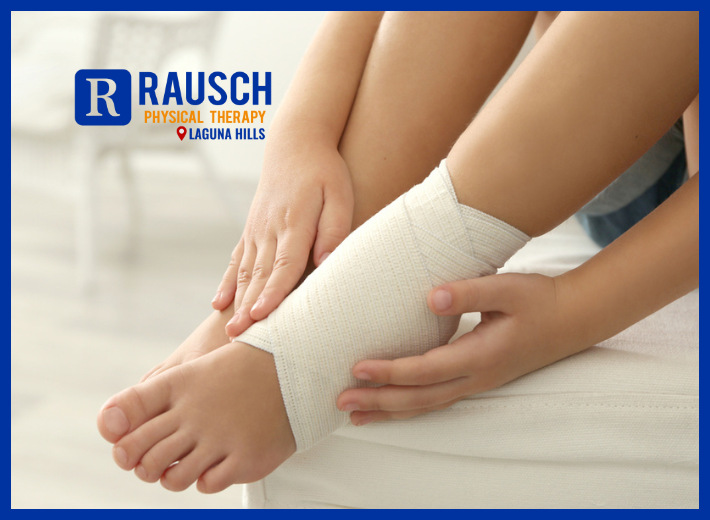Balancing a healthy diet and a consistent exercise routine can often feel like a complicated equation, but successful healthy living is truly about synergy, not sacrifice. The key to long-term,
Recovering From an Ankle Sprain
December 1, 2022 1:19 pm / Category: Rausch Physical Therapy

A sprained ankle is a common injury that occurs when the ankle ligaments are torn or stretched too far, often after a fall, or if you roll or twist your ankle. The majority of sprains heal on their own — but not always well — and treatment to strengthen the injured muscles can prevent future sprains. Learn how to recover from the injury — and then connect with us on how we can help you. Remember, you don’t need a prescription to see a PT — and our teams offer awesome, personalized recovery programs.
A sprained ankle is an injury that occurs when you roll, twist or turn your ankle in an awkward way. This can stretch or tear the tough bands of tissue (ligaments) that help hold your ankle bones together.
Ligaments help stabilize joints, preventing excessive movement. A sprained ankle occurs when the ligaments are forced beyond their normal range of motion. Most sprained ankles involve injuries to the ligaments on the outer side of the ankle.
Treatment for a sprained ankle depends on the severity of the injury. Although self-care measures and over-the-counter pain medications may be all you need, a medical evaluation might be necessary to reveal how badly you’ve sprained your ankle and to determine the appropriate treatment.
Symptoms
Signs and symptoms of a sprained ankle vary depending on the severity of the injury. They may include:
- Pain, especially when you bear weight on the affected foot
- Tenderness when you touch the ankle
- Swelling
- Bruising
- Restricted range of motion
- Instability in the ankle
- Popping sensation or sound at the time of injury
When to see a doctor
Call your doctor if you have pain and swelling in your ankle and you suspect a sprain. Self-care measures may be all you need, but talk to your doctor to discuss whether you should have your ankle evaluated. If signs and symptoms are severe, you may have significant damage to a ligament or a broken bone in your ankle or lower leg.
Causes
A sprain occurs when your ankle is forced to move out of its normal position, which can cause one or more of the ankle’s ligaments to stretch, partially tear or tear completely.
Causes of a sprained ankle might include:
- A fall that causes your ankle to twist
- Landing awkwardly on your foot after jumping or pivoting
- Walking or exercising on an uneven surface
- Another person stepping or landing on your foot during a sports activity
Risk factors
Factors that increase your risk of a sprained ankle include:
- Sports participation. Ankle sprains are a common sports injury, particularly in sports that require jumping, cutting action, or rolling or twisting of the foot such as basketball, tennis, football, soccer and trail running.
- Uneven surfaces. Walking or running on uneven surfaces or poor field conditions may increase the risk of an ankle sprain.
- Prior ankle injury. Once you’ve sprained your ankle or had another type of ankle injury, you’re more likely to sprain it again.
- Poor physical condition. Poor strength or flexibility in the ankles may increase the risk of a sprain when participating in sports.
- Improper shoes. Shoes that don’t fit properly or aren’t appropriate for an activity, as well as high-heeled shoes in general, make ankles more vulnerable to injury.
Complications
Failing to treat a sprained ankle properly, engaging in activities too soon after spraining your ankle or spraining your ankle repeatedly might lead to the following complications:
- Chronic ankle pain
- Chronic ankle joint instability
- Arthritis in the ankle joint
Prevention
The following tips can help you prevent a sprained ankle or a recurring sprain:
- Warm up before you exercise or play sports.
- Be careful when walking, running or working on an uneven surface.
- Use an ankle support brace or tape on a weak or previously injured ankle.
- Wear shoes that fit well and are made for your activity.
- Minimize wearing high-heeled shoes.
- Don’t play sports or participate in activities for which you are not conditioned.
- Maintain good muscle strength and flexibility.
- Practice stability training, including balance exercises.
Our physical therapy experts will evaluate your injury and customize a treatment plan that fits your needs. Don’t finish the year in pain. When it comes to your health, you have the option to request the best. Find our team at 949-597-0007 or meet us on our Facebook page.
Reference: [https://www.mayoclinic.org/diseases-conditions/sprained-ankle/symptoms-causes/syc-20353225]






